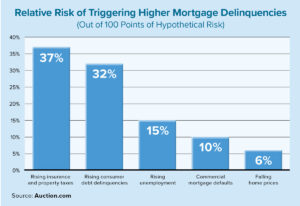A central role of being a commercial mortgage broker is that of an advisor. Offering candid, fact-based advice on a property, sector or the market in general is part of the job.
Experience will provide a basis for the advice brokers give their clients. But what if a broker has not had the experience of living through a point in time — such as the current one — with rising interest rates and historically high inflation? After all, the most recent period with similarly high interest rates and inflation was the late 1970s and early ‘80s, a time in which many of today’s commercial mortgage brokers had yet to enter the industry and others were not yet even born.
Still, that is no excuse for not understanding how inflation and rising interest rates can affect commercial real estate. By researching statistical analysis and the historical perspective of prior inflationary and rising-rate environments, brokers will gain the knowledge needed to offer sound advice to their clients, and they’ll prepare themselves for the future of the market and which sectors to focus on.
Inflation hedge
Historically, real estate has been seen as a hedge against inflation. During inflationary times, property values and rent prices tend to increase. The result is that cash flow also increases and the gains in commercial real estate values generally outpace inflation.
From 1978 to 1980, for example, inflation averaged 10.8%. It peaked in March 1980 at nearly 15%. During the same time period, interest rates averaged nearly 10% and reached an all-time high of 15.8% in 1981.
Looking at publicly traded equity real estate investment trusts (REITs) during these years, however, you’ll find that they had dividend incomes and total returns that averaged a respective 12.2% and 23.1% per year. In 1979, as inflation soared to a 32-year high, returns for REITs averaged 21.2%, according to research conducted by the National Association of Real Estate Investment Trusts and The Wharton School of the University of Pennsylvania.
Regardless of your age or experience as a mortgage broker, it is safe to advise clients that now is a great time to own commercial real estate.
This evidence supports the notion that increases in commercial real estate values outpaced inflation in the late 1970s and early ‘80s. So, there is reason to believe the same pattern will take place today and that investors are far better served focusing on commercial real estate than other types of investments.
For example, take stocks. An overview of the S&P 500 from 1974 to 1981 shows that the index delivered a 4.9% inflation-adjusted annual return, according to research platform Macrotrends. And while inflation averaged 9.3% per year during this time frame, equity REITs produced average annual incomes and returns of 10.2% and 16.3%.
Multifamily focus
So, regardless of your age or experience as a mortgage broker, it is safe to advise clients that now is a great time to own commercial real estate. This is especially true of multifamily housing properties, which are seeing rent increases outpace inflation in many areas of the country.
Why should investors focus on multifamily properties during periods of rising inflation? As previously addressed, inflation increases price appreciation and resulting rent levels. With fewer multifamily projects being developed due to rising labor and material costs, rents tend to increase. And as developments stall, the demand for existing multifamily housing increases and occupancy rates tend to increase as well.
Generally, multifamily properties utilize short-term leases that are no longer than one year, which allow landlords to reset pricing to market rates and combat inflationary pressures. Some landlords even use month-to-month leases, which afford more pricing-power flexibility. Price increases can be passed along to new tenants as long as demand remains high.
Fixed-rate mortgages
For property owners with a fixed-rate mortgage during these periods, the payments (aside from taxes, insurance and other expenses) remain constant. This improves their equity position while reducing the value of money owed in the future. This is a win-win situation.
Interest rate increases resulting from higher inflation can weaken investor demand and negatively impact commercial real estate. As discussed, however, historical data provides evidence that some commercial properties, including multifamily housing, are a good inflation hedge. Fannie Mae’s multifamily outlook for 2022 calls for rent growth of 4% to 5% (about half as much as 2021) and a 5.5% increase in origination volume.
At the same time, inflation and rising interest rates can put a damper on the owner-occupied housing market by making affordability more difficult. Hence, would-be buyers remain or become renters, which also ups demand for rental properties. So, it is easy to see why multifamily may be the sector of choice as investors grapple with inflation in the U.S. and abroad. As a commercial mortgage broker and advisor, this sector should be one to focus on.
Other property options
Another sector of commercial real estate worth focusing on during inflationary periods are triple net lease (NNN) properties. In these arrangements, the tenant pays for the property expenses, including the real estate taxes, insurance and maintenance (in addition to rent and utilities).
In general, NNN properties have performed well when compared to the inflation-adjusted returns through the S&P 500. Triple net lease properties with capitalization rates in the 4.5% to 6.5% range generally realize a 7% to 9% return on investment when all factors are considered.
With annual rent increases and rising costs for taxes, insurance and maintenance handled by the tenant, it is clear that NNN properties provide another viable alternative for investors. Although multifamily costs such as common-area maintenance, management fees, capital expenditures, etc. are borne by the landlord, NNN properties provide guaranteed (and in many cases) recession-proof income without these added expenses.
Other commercial real estate sectors that may benefit during this current period of high inflation are the hospitality and industrial segments. Hotels, which have been beleaguered due to the COVID-19 pandemic, are seeing a dramatic rise in demand as post-crisis leisure travel spikes. In turn, owner-operators are able to adjust their daily room rates to keep pace with inflation and take advantage of the increased demand.
Industrial properties have seen a surge in demand over the past several years due to the rise of e-commerce. Although tenants may seek to execute longer-term leases, owners have the pricing power when it comes to renewing or releasing these properties.
● ● ●
Each of these sectors are worth a look, whether your client is in the market to buy a single property or a portfolio of investments. Now that you have some perspective on the commercial real estate market during times of inflation and rising interest rates, do your research, focus on the sectors that are poised to do well and advise your clients accordingly. ●
Author
-

Rob Diodato is the president of York Commercial Finance, a commercial mortgage advisory company with offices in Dallas and New York. Diodato arranges financing for commercial real estate transactions nationwide for all property types. Diodato has more than 26 years of experience in the commercial and residential mortgage industries.




